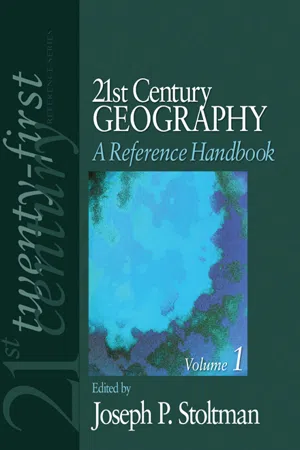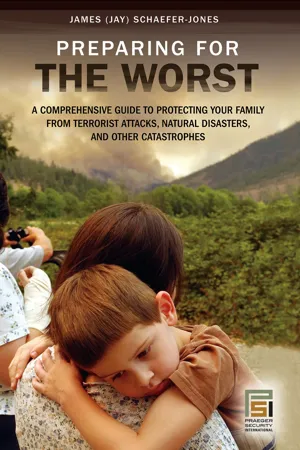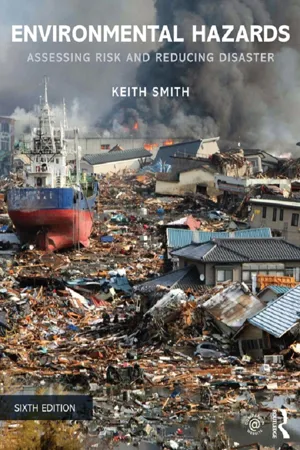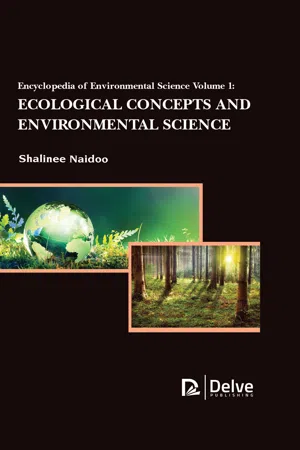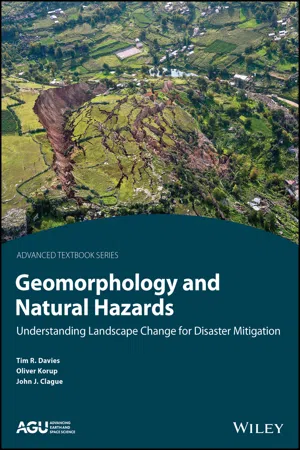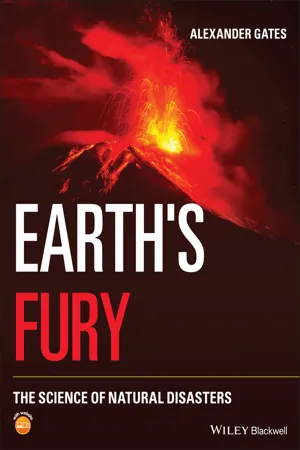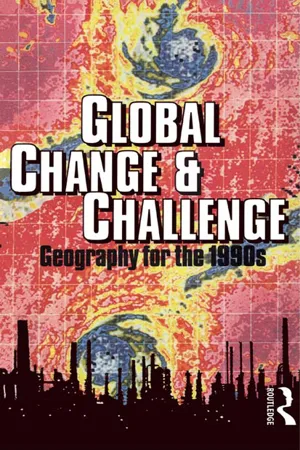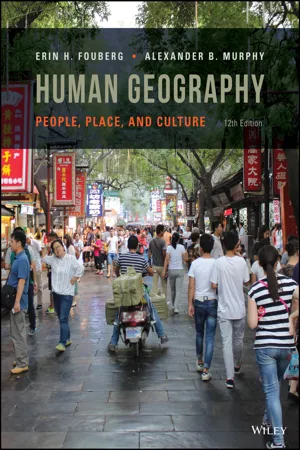Geography
Natural Hazards
Natural hazards are events or processes in the natural environment that pose a threat to human life and property. These can include earthquakes, floods, hurricanes, tsunamis, and volcanic eruptions. Understanding the causes and impacts of natural hazards is important for developing strategies to mitigate their effects and protect vulnerable communities.
Written by Perlego with AI-assistance
Related key terms
1 of 5
12 Key excerpts on "Natural Hazards"
- eBook - PDF
- Joseph P. Stoltman(Author)
- 2011(Publication Date)
- SAGE Publications, Inc(Publisher)
Frequently the terms natural hazard and natu- ral disaster are used synonymously, but in an academic sense, they are quite different. A natural hazard is the threat or likelihood of a geophysical event that negatively impacts the human-use system; it is not the geophysical event itself. Thus, Natural Hazards present different levels of risk at different locations from different geophysical forces. For example, communities along the Atlantic and Gulf Coasts of the United States are exposed to hurricanes and associated storm surges; villages around active volca- noes in Ecuador are prone to ash-falls, pyroclastic activity, and lava flows; and Chinese cities located along the flood- plains of the Yellow and Yangtze Rivers are subject to severe flooding. In fact, the world over, it is possible to identify potential disaster sites by documenting geophysi- cal processes and human activities. These examples are among those for which hazard zones can be identified with some level of certainty, and geographers have been at the forefront of mapping and analyzing the spatial dynamics through Geographic Information Systems (GIS), remote sensing techniques, and other technologies. For other haz- ards, however, such as tornadoes, droughts, and blizzards, it may be possible to determine regions of risk, but not precise hazardous locations. These locations may require different approaches for coping, mitigation, and adapta- tion. These topics are discussed in this chapter. A natural disaster, on the other hand, is the result of an event-after it has had an impact. Hurricane Katrina made landfall near New Orleans, Louisiana, and on the Gulf Coast of the United States; Mount Tungurahua in Ecuador 509 510 • NATURE AND SOCIETY has erupted on many occasions since 1999; and the Yangtze River and others have flooded large areas of southern China in 2010. - eBook - PDF
Preparing for the Worst
A Comprehensive Guide to Protecting Your Family from Terrorist Attacks, Natural Disasters, and Other Catastrophes
- James Schaefer Jones(Author)
- 2007(Publication Date)
- Praeger(Publisher)
CHAPTER 4 Natural Hazards This chapter includes information about many types of Natural Hazards. Natural Hazards are natural events that threaten lives, property, and other assets. Often, Natural Hazards can be predicted. They tend to occur repeat- edly in the same geographical locations because they are related to weather patterns or physical characteristics of an area. Natural Hazards such as flood, fire, earthquake, tornado, and windstorms affect thousands of people every year. We need to know what our risks are from Natural Hazards and take sensible precautions to protect ourselves, our families, and our communities. Use the information contained in this chapter to learn about the hazards that pose a risk to you. Include the pertinent information in your family disas- ter plan. Specific content on each hazard consists of the characteristics of that hazard, terms associated with the hazard, measures that can be taken before- hand to avoid or lessen the impact of these events, and what individuals need to do during and after the event to protect themselves. When you complete this chapter, you will be able to do the following: • Know important terms. • Take protective measures for Natural Hazards. EARTHQUAKES One of the most frightening and destructive phenomena of nature is a severe earthquake and its terrible aftereffects. An earthquake is a sudden movement 32 Preparing for the Worst of the earth, caused by the abrupt release of strain that has accumulated over a long time. For hundreds of millions of years, the forces of plate tectonics have shaped the earth, as the huge plates that form the earth’s surface slowly move over, under, and past each other. Sometimes, the movement is gradual. At other times, the plates are locked together, unable to release the accumulating energy. When the accumulated energy grows strong enough, the plates break free. If the earthquake occurs in a populated area, it may cause many deaths and injuries and extensive property damage. - Available until 4 Dec |Learn more
Environmental Hazards
Assessing Risk and Reducing Disaster
- Keith Smith(Author)
- 2013(Publication Date)
- Routledge(Publisher)
In this book, the term environmental hazard is limited to events originating in, and transmitted through, the natural and built environments that lead to human deaths, economic damage and other losses above certain predefined thresholds of loss. In fact, thresholds of loss are used to define disaster (see section 1.C, page 12). Hazards and disasters are two sides of the same coin; each merges into the other and neither can be fully understood from the standpoint of either physical science or social science alone. As shown in Figure 1.1, they are linked to wider issues like global environmental change and the many interacting factors that determine the prospects for sustainable development in the future. Two main types of environmental hazard can be identified (Table 1.1). 1 Natural Hazards The most important group of hazardous events is normally classed as ‘natural’. The United Nations International Strategy for Disaster Reduction (UN/ISDR, 2009) defined a natural hazard as: any natural process or phenomenon that may cause loss of life, injury or other health impacts, property damage, loss of livelihoods and services, social and economic disruption or environmental damage. Table 1.1 Major categories of environmental hazard Natural Hazards (extreme geophysical and biological events) Geologic — earthquakes, volcanic eruptions, landslides, avalanches Atmospheric — tropical cyclones, tornadoes, hail, ice and snow Hydrologic — river floods, coastal floods, drought Biologic — epidemic diseases, wildfires Technological hazards (major accidents) Transport accidents — air accidents, train crashes, ship wrecks Industrial failures — explosions and fires, release of toxic or radioactive materials Unsafe public buildings and facilities — structural collapse, fire Hazardous materials — storage, transport, misuse of materials Notes: Drought is a slow-onset natural hazard - eBook - PDF
- Stefano Campus, Secondo Barbero, Stefano Bovo, Ferruccio Forlati(Authors)
- 2007(Publication Date)
- CRC Press(Publisher)
1 Introduction to the Concept of Hazard and Risk 1.1 Forecasting, Hazard, and Risks Related to Natural Phenomena 1.1.1 INTRODUCTION What is a disaster? It can be defined as an extraordinary event that sur- passes the standard response capacity that an organization is prepared to sustain. They may range from emergency situations that regard a limited area and the elements directly involved (a traffic accident, a single isolated rock fall) to those events whose intensity can be managed only through the coordinated participation of national or international authorities, like the Tsunami of December 26th, 2004. An initial classification of various types of dangers may be made by considering the origins of such events; natural, technological, and social dangers (Table 1.1.1). EXAMPLES CLASS OF DANGER NATURAL Earthquake, volcanic eruption, landslide (including rockfall, debris avalanche, mudflow), episode of accelerated erosion, subsidence Geological Hurricane, tornado, icestorm, blizzard, lightning, intense rainstorm, hailstorm, fog, drought, snow avalanche Meteorological Flood, flashflood Hydrological Tsunami (geological origins), sea storm (meteorological origins) Oceanographic TECHNOLOGICAL Biological Wildfire, disease outbreaks (meningitis, cholera...) Devices and machines Hazardous materials and processes Dangerous processes Installations and plants Carcinogens, mutagens, heavymetals Bridges, dams, mines, refineries, power plants, oil and gas terminals and storage plants, power lines, pipelines, high-rise buildings Explosives, unexploded ordnance, vehicles, trains, aircraft Structural failure, radiation emissions SOCIAL Terrorist incidents Crowd incidents Bombings, shootings, hostage taking, hijacking Riots, demonstrations, crowd crushes and stampedes TABLE 1.1.1 CLASSES OF DANGERS (Alexander, 2002) - eBook - PDF
Encyclopedia of Environmental Science Vol1
Ecological Concepts and Environmental Science
- Shalinee Naidoo(Author)
- 2019(Publication Date)
- Delve Publishing(Publisher)
The hazards usually relate to some kind of environmental process or system which include topographical, atmospheric, geochemical, edaphic or hydrological systems to name a few. Environmental disasters can be broken down into four main areas namely geohydrological, chemical, industrial and climatic disasters. Ecological Concepts and Environmental Science 60 8.1. NATURAL DISASTERS Natural disasters are commonly defined as catastrophic events that occur as a result of nature or natural processes of the Earth. Natural processes such as weather patterns and energy flows, for example, in turn, affect vulnerable populations and surrounding environments leading to extensive damage and loss (Davis et al., 2010). These types of disasters include floods, earthquakes, hurricanes, tornadoes, tsunamis, mudslides, volcanic eruptions sinkholes, droughts and other related geological processes. The area in which these phenomenon occurs will determine if they are classified as a disaster or not. Those events that occur in unpopulated areas are not considered disasters so for example, a flood on a deserted island or a volcanic eruption in an unpopulated city would not be considered disasters. Natural disasters always cause some kind of loss in some way. Depending on the brutality of the natural disaster, loss of life, property damage and a great deal of environmental damage and economic loss can occur. The severity of the disaster is often measured in the number of lives lost, economic loss as well as the resilience of the surrounding environment and ability of the affected populations to recover and rebuild. Collapsing buildings, disruption of transport and societal livelihoods are often results from natural disasters which take a tremendous amount of time to recover from. In addition, personal effects are often great due to the loss of possessions and memorabilia of those affected. - eBook - ePub
Geomorphology and Natural Hazards
Understanding Landscape Change for Disaster Mitigation
- Timothy R. Davies, Oliver Korup, John J. Clague(Authors)
- 2021(Publication Date)
- American Geophysical Union(Publisher)
16 How Natural are Natural Hazards?We have seen that, to assess risk quantitatively, we need to gather information about the values at specific risk, their vulnerability, and the probability that a potentially damaging event will occur in the first place. In many cases, the psychological aspects of risk management, termed aversion, also play a role. We have tacitly assumed that all of these factors remain constant over time. This view may be convenient, but of limited use, to maintain in a world with a rapidly growing and expanding human population that is transforming much of its environment. Our short account on future sea-level changes and the contribution by human activities (Chapter 15.4) was but one example of how we increasingly interfere with natural systems, and hence Natural Hazards.Maintaining a static or stationary viewpoint on natural risks may be mathematically convenient, but ignores the many superimposed cycles, oscillations, and feedbacks in Earth's lithosphere, hydrosphere, atmosphere, and biosphere. For example, earth scientists estimate that up to 90% of all natural disasters are linked to meteorological phenomena. Hence, changing weather and climate should result in changing Natural Hazards and risks. In the light of this change, scientists are increasingly adopting statistical methods that recognize nonstationary processes to counter the reduced capacity for predictions that can arise from time-series data that have varying means and variances. Nevertheless, the more straightforward and traditional predictions based on the simplifying assumptions of stationarity may often give approximate enough results to be understood and used by practitioners (Montanari and Koutsoyiannis 2014 ). A confounding factor for predicting Natural Hazards and risks is that humans have interfered with many elements of the Earth system. Most seemingly natural processes bear an anthropogenic fingerprint. One major issue is whether we can still refer to Natural Hazards as ‘natural’. The scientific literature is now teeming with terms and labels such as ‘critical thresholds’, ‘tipping points’, ‘ecological footprints’, ‘carrying capacities’, and ‘planetary boundaries’ (Steffen et al. 2015 ) emphasizing that Earth's natural resources are finite, so there might be irreversible system changes that we need to consider seriously if sustainability is a concern (Figure 16.1 - eBook - PDF
Earth's Fury
The Science of Natural Disasters
- Alexander Gates(Author)
- 2022(Publication Date)
- Wiley-Blackwell(Publisher)
1 CHAPTER 1 Earth’s Fury: The Science of Natural Disasters, First Edition. Alexander Gates. © 2022 John Wiley & Sons Ltd. Published 2022 by John Wiley & Sons Ltd. Companion website: www.wiley.com/go/gates/earthsfury Introduction to Natural Disasters CHAPTER OUTLINE 1.1 What Is a Natural Disaster? 3 1.2 Why Do People Live in Dangerous Areas? 5 1.3 What Can We Do to Stay Safe? 8 1.4 Societal Response to Natural Disasters 9 1.5 How This Book Is Organized 14 What Is a Natural Disaster? 3 Words You Should Know: Earthquake – An event in which the breakage of rock along a fault within the earth causes the release of energy in the form of seismic waves. Disaster reduction engineering – Construction practices that are designed to reduce the impact of a natural disaster. Hurricane – A highly energetic, individual tropical storm that develops over warm ocean waters. Natural disaster – A natural event that causes loss of life or property, either directly or indirectly, as a result of the aftermath. Population growth – The increase in human population over time. Tsunami – Meaning “harbor wave” in Japanese, a tsunami is an energetic ocean wave generated by a physical event (earth- quake, volcano, landslide) on the earth’s surface. Volcano – The geographic feature resulting from the release of lava and/or solid ejecta from a vent in the earth. 1.1 What Is a Natural Disaster? Humans seek to protect their lives at all costs. Major efforts and enormous amounts of money are devoted to medications and medical procedures that can increase human life by even a short amount of time. These efforts have increased the average life span worldwide and protected people from many natural threats. This increased protection has led to a sense of security among many of not having to worry about the threats, especially in the developed world. - eBook - ePub
Global Change and Challenge
Geography for the 1990s
- Robert Bennett, Robert Estall(Authors)
- 2012(Publication Date)
- Routledge(Publisher)
environmental hazards . It is essential to recognise that both ‘resources’ and ‘hazards’ are human assessments or cultural appraisals and are, as such, intimately interrelated. Few phenomena can be deemed wholly good or wholly bad, the vast majority are combinations of the two. Thus ‘resources’ and hazards should not be visualised as entirely separate groups of phenomena but rather as separate parts of a continuous spectrum. Whether phenomena are deemed beneficial ‘resources’ or damaging ‘hazards’ depends on the balance between their perceived ‘costs’ and their perceived ‘benefits’. This, in turn, is largely dependent on the state of cultural development of the affected society.In this chapter we will first examine six common misconceptions about hazards. The chapter then examines the global significance of Natural Hazards, the reasons for increasing hazard impacts and the various management options available to reduce the costs of hazards.COMMON MISCONCEPTIONS ABOUT NATURALHAZARDS
The overemphasis on disasters
Mention of the term ‘Natural Hazards’ generally invokes images of violent events—hurricanes, floods, tsunamis, earthquakes, volcanic eruptions, the collapse of mountain slopes—which result in widespread death, destruction and desolation. The media, and especially television, are increasingly dominated by harrowing images: the 1988 Armenian earthquake, hurricanes Gilbert and Hugo (in 1989), and the Californian earthquake (in 1989). Even the UK has had its share of destruction in recent years, with hurricane strength storms in October 1987 and January–February 1990, and major flooding by rivers (e.g. the Severn and at Maidenhead in 1990) and the sea (at Towyn, North Wales, in 1990).It is undoubtedly true that very destructive events do take place, which sometimes have disastrous consequences for the societies affected. But the term ‘disaster’ is properly used only when the costs of an impact are very great. Disasters are, in reality, relatively infrequent (low frequency) large scale (high magnitude) hazard impacts. Such hazardous events are at one end of a continuum that includes numerous occurrences of medium sized impacts and large numbers of small events, many of which are so minor as to be inconspicuous and unnewsworthy. For any type of hazard, therefore, it is important to examine its frequency of occurrence and compare it with the size of its impact. Such magnitude-frequency distributions show a few high magnitude-low frequency events (potential disasters) at one extreme, and a large number of low magnitude-high frequency events at the other, as shown in Figure 2.1 - eBook - PDF
Human Geography
People, Place, and Culture
- Erin H. Fouberg, Alexander B. Murphy(Authors)
- 2020(Publication Date)
- Wiley(Publisher)
Natural Hazards are created by Earth processes, including movement of lithospheric plates (tectonic change), movement of water (hydrological change), and weather or climate (meteorological or climatological change). 2. Earth’s lithosphere, or upper mantle and crust, is divided into more than 15 plates. Tectonic Natural Hazards most often happen along boundaries between plates. Plates can diverge (spread apart), con- verge (come together), or transform (slip past each other). When two plates of different densities converge, they form a subduction zone. The oceanic plate is denser and goes under the continental plate at the converging plate boundary. Subduction zones create massive earthquakes under the ocean, which generate destructive seismic sea waves called tsunamis. How much damage a natural disaster like a tsunami causes in terms of human lives and property damage depends on the country and whether it has a tsunami warning system. The Indian Ocean tsunami in 2004 killed 230,000 people and did more than $10 billion in damage to coasts of Indonesia and Thailand. The 3/11 tsunami in Japan in 2011 killed 15,000 people and did an estimated $235 billion in damages. 3. A flash flood happens when excessive rain or meltwater from snow overflows rivers, fills dry riverbeds, and causes a rapid rise in water levels in a short time. Flash floods are increasingly com- mon because climate change has warmed oceans, which makes evaporation rates higher. Flash floods often happen in cities near infrastructure and buildings because impervious surfaces do not absorb rainwater, creating conditions for flooding if the storm drainage system is not well built or cannot handle the quantity and frequency of rainwater. 4. Monsoons are predictable patterns of winds coming from a cer- tain direction for an extended period. Monsoon rains are welcome because they flood rice fields and regenerate rivers. However, cli- mate change is making monsoon rains less predictable and more extreme. - eBook - PDF
Geomorphology and Natural Hazards
Proceedings of the 25th Binghamton Symposium in Geomorphology, Held September 24-25, 1994 at SUNY, Binghamton, USA
- M. Morisawa(Author)
- 2013(Publication Date)
- Elsevier Science(Publisher)
Some of these other hazards have been recently reviewed (e.g. Sherman and Nordstrom, 1994), whereas others, such as glacial movement or periglacial effects, are limited in their effect on human populations, or have received little attention as hazards. We have chosen to place geomorphology within the context of the original Natural Hazards paradigm (White, 1974a) for ease of discussion. We recognize the importance of socio-economic factors in creating hazardous conditions and point to this as an important area of future research. Ultimately, resolution of Natural Hazards problems must incorporate economics and society, and geomorphologists must be able to recog-nize how the natural systems are affected by human systems. In accordance with the first two goals of the Natural Hazards paradigm (White, 1974a), we contend that the physical aspects of a hazard event can be evaluated in terms of 5 components: (1) the dynamics of the phys-ical processes; (2) the prediction of the occurrence; (3) the determination of the spatial and temporal char-acteristics; (4) an understanding of the impact of phys-ical characteristics on people's perception; and (5) knowledge about how the physical aspects can be used to formulate adjustments to the event. 4.1. Soil erosion by water Unlike many natural disasters, there is no direct loss of life as a result of soil erosion, but it has a widespread distribution, high remediation costs, a potential for soil deterioration, and reduced food production. Evans (1990) shows that 36% of arable soils in England and Wales are at risk from moderate- to very high-erosion. An evaluation of costs associated with soil erosion in southern Ontario, Canada (Table 2) shows the degree to which the problem impinges on the human system. According to Wall and Dickinson (1978), total cost approached US$ 95 million in 1976; using the con-sumer price index, this cost is equivalent to about US$ 250 million in 1994 dollars. - Jonathan Rougier, Steve Sparks, Lisa J. Hill(Authors)
- 2013(Publication Date)
- Cambridge University Press(Publisher)
16.8 Concluding comments The number of people living at risk from Natural Hazards is on the increase as a consequence of population growth and urbanisation. The frequency of some hazards may also be increasing, perhaps due to climate change. While our understanding of the physical hazards is improving, this is only one aspect of disasters and emergency management. The primary driver behind trying to predict hazards accurately is to reduce the loss of life, yet human 1 The ‘global South’ refers to those countries with a Human Development Index (HDI) score below 0.8, most of which are located in the Southern Hemisphere. Natural Hazards and risk 561 behaviour is also uncertain in the face of risk and is liable to variation over time and as external factors change. Human decision-making is much more complex than simply a ‘rational’ information- processing task carried out by individuals. Perceptions may differ depending on the type of risk, the risk context, the personality of the individual and the social context (Wachinger and Renn, 2010: 8). Therefore, the definition of what is a ‘common sense’ response to a given scenario will vary greatly across individuals and groups and comprise what are often unex- pected, even counter-intuitive, behaviours. It is often these behaviours that risk managers try to change through providing more information about the risk, but this often does not have the desired effect. Taking the time to understand the roots of these beliefs and behaviours can go a long way in helping to find ways of tackling them, where this is necessary. The concept of place attachment (to either a physical location or community) may explain some of the resistance by local populations to being moved from a hazardous area, either in advance of an event or emergency evacuation during the event itself. However, cultural differences may also account for the manner in which people respond to environmental threats.- Michael K. Lindell, Carla Prater, Ronald W. Perry(Authors)
- 2012(Publication Date)
- Wiley(Publisher)
The Natural Hazards are commonly categorized as meteorological, hydrological, or geophysical. ▲ Technological hazards originate in human-controlled processes but are released into the air and water. The most important technological hazards include explosives, flammable materials, toxic chemicals, radiological materials, and biological hazards. Some- times terrorists deliberately release technological hazards to meet political objec- tives. Whether a hazardous release is accidental or deliberate might make a dif- ference in the magnitude of the impact but not the types of impacts emergency managers must confront. You must know how to confront and deal with all types of hazards. This chapter discusses various types of hazards: meteorological, hydrologi- cal, geophysical, and technological. It also examines the risks and the effects and describes how to deal with them. As is the case with other emergencies, you must know how to work with others to deal with hazards. This chapter looks at how to do this when dealing with hazards. 5.1 Meteorological Hazards The main meteorological hazards are severe storms (including blizzards), severe summer weather, tornadoes, hurricanes, and wildfires. 5.1.1 Severe Storms The National Weather Service (NWS) defines a severe storm as one that has wind speeds exceeding 58 mph, that produces a tornado, or that releases hail with a diameter of three-quarters of an inch or greater. The threats from severe storms are: ▲ Lightning strikes ▲ Downbusts and microbursts ▲ Hail ▲ Flash floods Lightning can cause casualties. However, casualties are rare and are easily handled by local emergency medical services units. The bigger threat is that light- ning strikes can initiate wildfires that threaten entire communities. This is espe- cially true during droughts. Downbursts (up to 125 mph) and microbursts (up to 150 mph) are threats to aircraft as they take off or land. This creates a poten- tial for mass casualty incidents.
Index pages curate the most relevant extracts from our library of academic textbooks. They’ve been created using an in-house natural language model (NLM), each adding context and meaning to key research topics.
